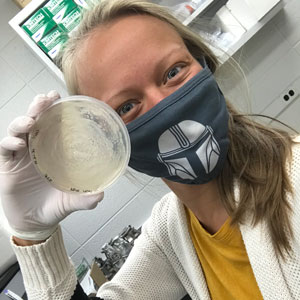
One of the most widely prescribed drugs in the world is wildly inefficient. Patients gulp down a large pill and the vast majority goes straight into the toilet.
The drug — called metformin — is the focus of a new project led by Thomas Niehaus, an assistant professor in Plant and Microbial Biology. Commonly used to treat type II diabetes, the drug’s journey doesn’t end in the porcelain bowl, and researchers are, in part, hoping to figure out why.
Sewer pipes transport metformin — alongside stinky company — to nearby wastewater treatment plants. These plants leverage a wide array of tactics to remove contaminants, including heat, filtration and microbes. After a few days and countless steps, the sludge (yes, that’s the technical term) is released as clean, clear water into nearby streams and rivers.
Although invisible to the naked eye, metformin enters those waterways. Much like metformin evades the gut and mostly ends up in a patient’s toilet, it evades every hoop in the treatment facility. Because of this, metformin takes the title as the most prevalent pollutant found in surface water globally.
Recently, researchers have found that the drug negatively impacts fertility and the development of aquatic species in those waterways. Niehaus and colleagues are eager to find a strategy to limit inundation of waterways by this drug.
“There is a lot known about how compounds are synthesized, but a lot less is known about how compounds are degraded or broken down. We are interested in learning how metformin is metabolized and hope to develop strategies to remove it from our waterways,” says Niehaus.
Unusual buffet
Katie Hillmann, a graduate student in the Niehaus lab, started working on the project in September, thanks to support from a MnDRIVE Grant.
Just like any research project, before the work can begin, researchers must collect all the necessary supplies and samples. For this project, that meant a trip to the local wastewater treatment facility for a sludge collection.
Within just a small sludge sample, billions of bacteria thrive. Many bacteria gain energy by breaking down chemical compounds. Bacteria don’t break the bonds on their own though. Bacterial DNA includes instructions for making enzymes — or proteins that specialize in breaking chemical bonds and speeding up the reactions. Often, it takes a team of enzymes, generated from numerous bacteria, to break down complex chemical compounds.
Since metformin is commonplace in wastewater, researchers suspected that a handful of bacteria in the sludge break down metformin to gain energy. In order to isolate these bacteria, they needed to see if any bacteria in the sludge could survive on a metformin-only diet.

Hillmann took swabs of the sample and smeared them across a petri dish only containing metformin, creating a buffet for metformin-degrading bacteria. Over the course of a couple days, any bacteria that cannot break down metformin to use as a food source will die.
The next day Hillmann returned to the lab and to her surprise, bacteria were already growing on the petri dish. “We did a happy dance in the lab,” she said. The researchers weren’t expecting growth for at least two days. Even then, they were worried no bacteria would dig into the metformin-only buffet.
Past the petri dish
With at least five species of metformin-degrading bacteria thriving on petri dishes, researchers will soon send off samples for genomic sequencing.
“In this project, we’re hopeful to identify the genes that produce metformin-degrading enzymes,” says Niehaus. “From there, we want to figure out how common they are in wastewater by looking at sludge from around the world.”
The larger research team includes several collaborators. One is just a building away. Larry Wackett, a Distinguished McKnight University Professor in Biochemistry, Molecular Biology, and Biophysics, studies enzymes involved in later stages of metformin breakdown. Down the street, researchers are working with Alison Ling at Barr Engineering Company, who is an expert in wastewater management. Another collaborator is across the Atlantic. A lab at the Swiss Federal Institute of Aquatic Science and Technology specializes in sequencing populations of bacteria in sludge and their expertise will prove crucial in the next phase of the project.
By figuring out the prevalence of metformin-degrading enzymes globally, researchers hope to eventually inform mitigation strategies in wastewater treatment facilities, which could involve adding metformin-degrading bacteria to the sludge.
In addition, despite the prevalence of metformin use, the exact pathway in the human gut is murky. If researchers can identify a suite of enzymes that break down metformin in sludge, they might be able to sort out how the drug is processed in a patient.
Sorting out how the elusive drug largely evades absorption in a patient and wastewater treatment plant mitigation systems won’t come easily, but the implications are profound for human health and the environment. —Claire Wilson